Tungsten-Halogen Light Sources
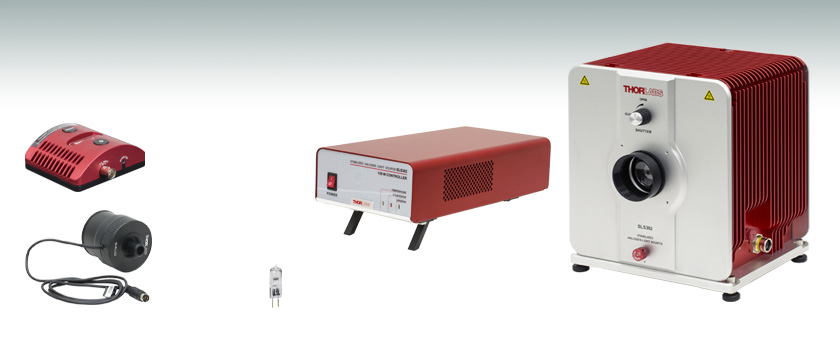
- >1.6 W Power Light Source with 360 - 3800 nm Output
- >10 W Power Light Source with 360 - 2500 nm Output
- Stabilized Color Temperature and Output Power
- Long Lamp Lifespan: 1000 Hours (Average)
SLS302
Stabilized Tungsten-Halogen Light Source,
350 - 2700 nm, >10 W Output
SLSLLG2
Liquid Light Guide
Adapter with Shutter
and Controller
Controller Included
SLS301B
Replacement Lamp

Please Wait
| Key Specificationsa | |||
|---|---|---|---|
| Item # | SLS301 | SLS302 | |
| Lamp Type | Stabilized Quartz Tungsten-Halogen | ||
| Wavelength Range | Front Portb | 360 - 2700 nm | 360 - 2500 nm |
| Back Portc | 360 - 3800 nm | - | |
| Color Temperature | 3400 K | ||
| Output Optical Power | >1.6 W | >10 W | |
| Output Beam Diameter | 35 mm | 46 mm | |
| Output Power Stabilityd | 0.05% | ||
| Optical Drift per Hour (Typical) | 0.01% | ||
| Optical Power Drift per °C (Typical) | 0.1% | ||
| Lamp Electrical Power | 150 W | ||
| Lamp Lifespan (Average) | 1000 Hourse | ||
Features
- Quartz Tungsten-Halogen Lamp for High-Power, Broadband Output
- Two Options:
- SLS301: 360 - 3800 nm Wavelength Range, >1.6 W Output Power
- SLS302: 360 - 2500 nm Wavelength Range, >10 W Output Power
- Collimated Output for Free-Space Applications
- Internally SM2-Threaded Aperture
- Four 4-40 Threaded Holes for 60 mm Cage Systems at Front Port
- SLS301 Source Also Supports 30 mm Cage Systems at Back Port
Optional Accessories
- Liquid Light Guide Adapters with or without Integrated Electronic Shutter
- Replacement Lamp
Thorlabs' SLS301 and SLS302 Tungsten-Halogen Light Sources provide stable, high-power illumination from VIS to NIR wavelengths. The SLS302 source incorporates a concave mirror and high-current electronics for >10 W output optical power, while the SLS301 source offers >1.6 W of output power and has a back port for access to uncollimated light at longer wavelengths. See the Specs tab above for complete specifications. Each light source features an internal feedback system to provide highly stable output power (0.05% fluctuation). Since the blackbody spectrum of these sources includes both the visible and infrared spectral ranges, these sources are ideal for integration into optical measurement equipment, such as back illumination for a test target as part of a detector calibration system.
Each tungsten-halogen light source includes a lens to collimate the output into a Ø35 mm (SLS301 source) or Ø46 mm (SLS302 source) beam for free-space applications. For convenience, the position of the collimation lens is factory set; however, it is also user-adjustable should slight tweaks to the collimation be necessary. For additional mechanical stability, the feet are removable, allowing the source to be bolted directly to any standard imperial or metric optical table with user supplied 1/4"-20 or M6 screws, respectively. The front face features four 4-40 taps (as shown in the image to the lower right) for 60 mm cage rods, making these devices compatible with Thorlabs' 60 mm cage system. Using the cage system, it is possible to incorporate various optic mounts that are centered along the optical center of the lamp. The back face of the SLS301 light source also offers 4-40 taps for compatibility with our 30 mm cage system.
A variety of accessories is available separately below. Adapters designed to integrate Ø3 mm or Ø5 mm core liquid light guides are threaded directly onto the output port of the source; this does not require the removal of the collimating lens. The adapters are available with or without an integrated electronic shutter. Please note that the SLS302 source should not be used with our liquid light guides (LLGs) without active cooling of the LLG to prevent overheating and burning of the LLG tips. Replacement lamps are also available. Please see the Lamp Replacement tab for detailed instructions.
If a higher color temperature is desired, our color-balancing filters can be used to attenuate red light from a light source while passing blue light. This results in a beam with a higher color temperature and lower total power.
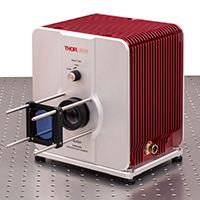
Click to Enlarge
Benchtop Light Source with 60 mm Cage System and
LCP05A(/M) Filter Mount with Color-Balancing Filter
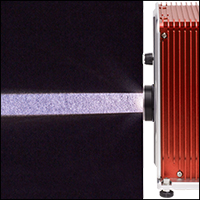
Click to Enlarge
Collimated Output
| Item # | SLS301 | SLS302 |
|---|---|---|
| Lamp Type | Quartz Tungsten-Halogen | |
| Wavelength Range | 360 - 2700 nm 360 - 3800 nm from the Back Port |
360 - 2500 nm |
| Color Temperature | 3400 K ± 15 K | |
| Output Optical Power | >1.6 W | >10 W |
| Typical Spectral Output | 0.05 W (360 - 400 nm) 0.15 W (400 - 700 nm) 1.4 W (700 - 2700 nm) |
0.4 W (360 - 400 nm) 1.2 W (400 - 700 nm) 8.4 W (700 - 2500 nm) |
| Optical Power Stabilitya | 0.05% | |
| Optical Drift per Hour (Typ.) | 0.01% | |
| Optical Power Drift per °C (Typ.) | 0.1% | |
| Output Beam Diameter | 35 mm | 46 mm |
| Beam Divergenceb | 3.5° | |
| Lamp Electrical Power | 150 W | |
| Lamp Lifespan (Average) | 1000 Hoursc | |
| Lamp Housing Dimensions (L x W x H) |
213.6 mm x 217.0 mm x 261.2 mm (8.41" x 8.54" x 10.28") |
217.0 mm x 218.9 mm x 264.5 mm (8.54" x 8.62" x 10.41") |
| Controller Dimensions (L x W xH) |
300.0 mm x 150.0 mm x 79.5 mm (11.81" x 5.91" x 3.13") |
300.0 mm x 150.0 mm x 83.9 mm (11.81" x 5.91" x 3.30") |
| Operating Temperature | 0 °C to 45 °C | |
| Storage Temperature | -15 °C to 70 °C | |
| SLS301B Lamp Specifications | |
|---|---|
| Wavelength Range | 360 - 3800 nm |
| Lamp Type | Quartz Tungsten-Halogen |
| Color Temperature | 3400 K |
| Lamp Electrical Power | 150 W |
| Glass Envelope Material | Quartz |
| Filament Dimensions (Typ.) | 6.5 mm x 1.3 mm x 3.3 mm |
| Filament Turns | 20 |
| Luminous Flux | 3700 Lumens |
| Lifespan (Average) | 1000 Hours |
| Operating Voltage | 24 V |
Liquid Light Guide Adapter Specifications
| Item # | SLSLLG1 | SLSLLG2 | SLSLLG3 |
|---|---|---|---|
| Wavelength Range | Uncoated: 185 nm - 2.1 µm | AR Coated: 350 nm - 700 nm; Ravg < 0.5% | |
| Integrated Electronic Shutter | No | Yesa | No |
| Lens | LA4464 | ACL5040U-A | |
| Lens Material | UV Fused Silica | B270 Optical Crown Glass | |
| Coupling Efficiency (with SLS301)b | >15% (3 mm LLG); >25% (5 mm LLG) | >20% (3 mm LLG); >30% (5 mm LLG) | |
SLS301 Stabilized Quartz Tungsten-Halogen Source
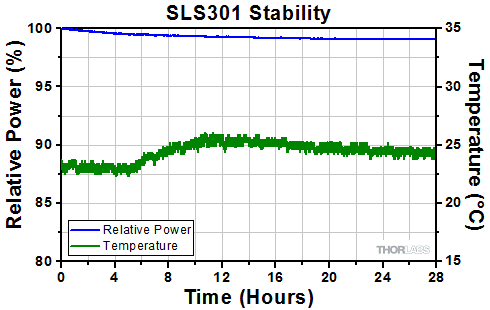
Click to Enlarge
The power output and temperature of an SLS301 light source were measured over 28 hours of continuous operation. The source was run for 30 minutes to warm up and stabilize before this data was taken.
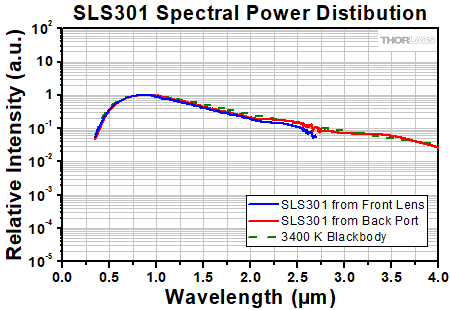
Click to Enlarge
Click for Raw Data
The measured spectral power distribution for the SLS301 light source.
SLS302 High-Power Stabilized Quartz Tungsten-Halogen Source
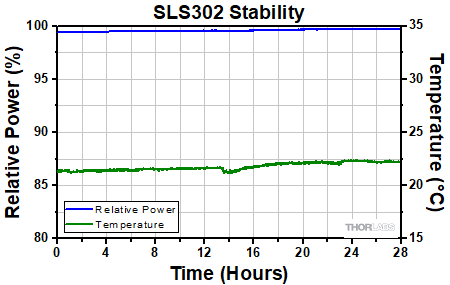
Click to Enlarge
The power output and temperature of an SLS302 light source were measured over 28 hours of continuous operation. The source was run for 30 minutes to warm up and stabilize before this data was taken.
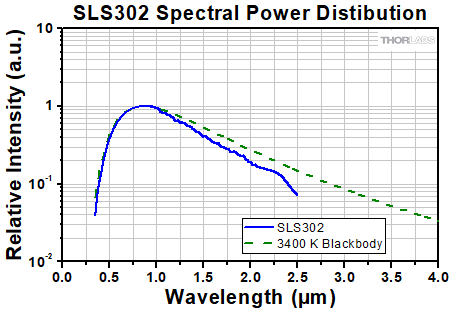
Click to Enlarge
Click for Raw Data
The measured spectral power distribution for the SLS302 light source.
Lamp Handling
The lamps used in broadband light sources have a high internal pressure and operate at a very high temperature. If handled incorrectly, they will become a serious hazard to users and could potentially cause severe injury. It is critical to follow safety instructions when handling them.
The guidelines below describe safe lamp handling.
- Due to the high internal pressure, the glass of a broadband light source can burst when handled incorrectly, even when not in operation, causing serious injuries. Always wear eye/face and body protection when handling a lamp.
- Never bump, drop, apply excessive stress, or scratch the lamp. This could cause it to burst.
- Always transport the lamp in the provided protective case or cover until installation.
- Save the protective case or cover and packaging materials (box) for lamps that have been used to their rated service life.
- Any dust or grease on the lamp will compromise the integrity of the glass envelope, increasing the chance that the lamp will burst. Clean any dirt, oil, or lint away from the lamp with alcohol and a lint free cloth or tissue.
- Always wear gloves when handling the lamp; never hold the lamp by its envelope. Thorlabs offer gloves that can be used for lamp handling.
- The lamp generates very high-intensity light output; never stare directly into the lamp.
- The lamp gets very hot during operation. Always wait at least 30 minutes after operation for the lamp to cool down before handling.
- Electrostatic discharge (ESD) protection is recommended when handling the lamp.
Lamp Replacement
The installation instructions and video below detail the recommended procedure for replacing the lamp in our SLS301 and SLS302 Tungsten-Halogen Light Sources using the SLS301B Replacement Lamp. Do not attempt to change the lamp while the lamp and lamp housing are hot. Allow at least 30 minutes after turning the light source off before attempting to replace the lamp.
We strongly recommend wearing gloves when replacing the lamp to prevent skin oils from being deposited onto the lamp. If you suspect the lamp is dirty, carefully clean it with alcohol before connecting it to a power supply.
Open the Lamp Housing
- Using a 4 mm hex key, remove the screws on the side plate. An engraving on the top of the unit indicates which side plate to remove.
Remove the Old Lamp
- Loosen the two thumbscrews locking the lamp in place by turning them counterclockwise.
- Remove the old lamp by holding the flat part beneath the glass envelope. The lamp can be rested in the temporary lamp holder inside the lamp housing.
Install the New Lamp
- Insert the new lamp into the lamp base.
- Tighten the two thumbscrews by rotating them clockwise.
- Replace the side panel and secure with the four M5 cap screws.
SLS301 and SLS302 Controller Connectors
 10-Pin Female Connector
10-Pin Female Connector| 10-Pin Female Connector | |||
|---|---|---|---|
| Pin | Connection | Pin | Connection |
| 1 | Bulb Ground | 6 | Ground |
| 2 | Bulb +24 V | 7 | Ground |
| 3 | Ground | 8 | +12 V |
| 4 | Monitor PD Signal | 9 | Signal Ground |
| 5 | Signal Ground | 10 | Ground |
Analog Output, 0 to 5 V
SLSLLG2 Shutter Interface Connector
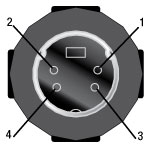
Male Plug on 35" (889 mm) Long Shutter Cord
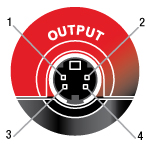
Female Jack on Controller
| 4-Pin Mini-DIN Connector | |
|---|---|
| Pin | Connection |
| 1 | Shutter Detect |
| 2 | Modulation + |
| 3 | +5 VDC |
| 4 | Modulation - |
| Shield | GND |
External Modulation Input: TTL 0 to 5 V, Female BNC
Interlock Output: 2.5 mm Mono Phone Jack
| Posted Comments: | |
Zhuoming Zhang
(posted 2024-04-16 14:25:14.14) Hi there,
I'm reaaching out to inquire about some technical details regarding two products: SLS302 and SLS301.
Firstly, I would like to inquire whether there are any available raw data from stability tests conducted on the products. Having access to the raw data would greatly assist in our assessment of the products' stability.
Secondly, regarding the stability tests conducted at 1Hz frequency, I am curious to know how the stability measures would fare under higher frequencies such as 100Hz or above. Could you provide insights into the stability performance at these higher frequencies?
Lastly, I am interested in understanding the frequency at which the stability feedback loop is calibrated. Knowing the adjustment frequency of the stability feedback mechanism would help us better comprehend the product's performance dynamics.
Your prompt response to these inquiries would be greatly appreciated as it would facilitate our decision-making process. Thank you in advance for your attention to this matter.
Best regards,
Zhuoming cdolbashian
(posted 2024-04-26 01:09:14.0) Thank you for contacting Thorlabs. To answer each question directly: 1. We will contact you to provide the raw data. 2. In principle the halogen lamp is very stable in short term and does not have high frequency noise. 3. Our feedback circuity is very slow (with second level response time) and it does not respond to any high frequency noise at all. FEI LI
(posted 2024-03-23 00:30:07.1) Hello, what is the model of the connection cable between the SLS302 host and the halogen light source cdolbashian
(posted 2024-03-29 12:06:45.0) Thank you for reaching out to us with this inquiry. As of now, this component is not a stock part on our website. I have contacted you directly, via email, to assist in the acquisition of such a part for you. Alexander Novikov
(posted 2023-10-03 15:18:12.233) Hi, we want to couple the light from SLS303 into a short fiber with 400 or 600 µm core. Would standard plano-convex/aspherical lenses or parabolic mirrors be suitable for it? What would be the coupling efficiency or power output from the fiber (for wavelengths about 4 µm)? Thanks. cdolbashian
(posted 2023-10-20 10:52:41.0) Thank you for contacting Thorlabs. Since the beam from the light source SLS303 has a very large area-solid angle product while the multimode fiber has a very small one, the coupling efficiency will be extremely low. Parabolic mirrors would be the best way to couple light here as you will have minimized chromatic focal shift. We will contact you directly for more discussion. f besson
(posted 2023-02-21 15:53:02.65) Hello,
Can you clarify lamp power stability and lifespan specifications for SLS301 and SLS302.
In overview specifications, optical power is said to be (b. at the beginning of the bulb lifetime.) while in the manual, it is said the optical power will not decrease during its lifetime.
Also, bulb lifetime is defined to be 1000hours (e. Defined as the time after which the controller cannot stabilize the output power of the bulb.)
Is that the life time to consider for a constant optical power before it starts decreasing?
To sum up:
- what is life time for constant stabilized power at specifications (>1.4 W and 10W)?
- controller led turns yellow at 75% bulb lifetime. is it 75 %*1000hours or 1000 hours.
Thanks for your answer. cdolbashian
(posted 2023-04-03 09:31:48.0) Thank you for contacting Thorlabs. The bulb lifespan in SLS301/SLS302 is defined as the time after which the controller cannot stabilize the output power of the bulb and the brightness starts to drop. The 1000 hrs is an average value and varies from unit to unit. When the bulb reaches to 75% lifespan (750 hrs in average), the life time warning LED will turn yellow. Christopher Hall
(posted 2023-01-10 22:43:16.197) Hi. I would like to use this light source to measure the spectrally dependent throughput (ie. intensity) for a spectrometer. Does the Stabilized Quartz Tungsten-Halogen Source (SLS301) come with a traceable spectral calibration dataset? Thanks. cdolbashian
(posted 2023-01-23 01:23:41.0) Thank you for contacting Thorlabs. These SLS* lamps are not calibrated. The light source is a typical incandescent lamp. The output brightness will gradually drop to about 50% throughout this life span. Also the stability spec is only valid after the light source reaches a thermal equilibrium. Between power cycles or when there is a temperature change in environment, the light source may drift and stabilize on a different equilibrium, causing a change in the mean power output. user
(posted 2022-12-01 14:14:09.54) Is the manual shutter able to reduce the beam diameter while keeping the beam circular, or do I need to buy an external diaphragm such as the LCP50D? cdolbashian
(posted 2022-12-02 04:28:38.0) Thank you for contacting Thorlabs. The manual shutter only has open and close positions. If you want to control the output beam diameter, using an external diaphragm such as the LCP50D is a good choice. Please note that there will be some spill light outside the diaphragm, which can be blocked with the lens tube. Lisa Du
(posted 2021-07-06 15:26:56.69) 我想了解下,这个有没有标定后的光谱曲线图,或者是类似出厂报告?可以给我电话沟通 13124818490 YLohia
(posted 2021-07-07 02:58:23.0) Hello, an applications engineer from our team in China (techsupport-cn@thorlabs.com) will discuss this directly with you. Sangyeon Youn
(posted 2020-10-06 01:52:36.633) Hello,
I am Sangyeon Youn.
We are using a high power light source that we bought from you before. (MODEL# : HPLS-30-04 / SERIAL# : 150701-1)
However, we can not find the cable which is connecting the light source and a power supply. (28VDC 8.5A cable)
Could I purchase this item separately?
If you can sell this item, please send the quote for purchasing.
If not, please let me know the information for purchasing. (Model name or vendor etc,)
I look forward to your reply.
Thank you!
Sincerely,
Sangyeon Youn asundararaj
(posted 2020-12-18 09:14:56.0) Thank you for contacting Thorlabs. HPLS-30-04 has been discontinued. I have contacted you directly via email on this. Slava Kachkanov
(posted 2020-06-17 16:48:58.25) Hi,
What is the lens is installed in SLS303?
I'm interested in focal length, transmission coefficient and circle of least confusion.
Thank you,
Slava YLohia
(posted 2020-06-18 08:12:33.0) Hello, there is a 2" diameter ZnSe plano-convex lens installed at the front of SLS303 with EFL=81.89 mm and BFL=79.61 mm @ 580 nm. Transmission of ZnSe between 550nm and 15μm is around 60-70%. Unfortunately, we do not have circle of least confusion spec for the lens as it's not used for imaging. Please email us at techsupport.uk@thorlabs.com for future requests. Slava Kachkanov
(posted 2020-06-17 06:35:11.83) Hi,
What is the beam divergence of this source? YLohia
(posted 2020-06-18 08:12:37.0) Hello, thank you for contacting Thorlabs. The SLS303 has a FWHM beam divergence of 5 degrees. The 10% beam divergence value is 40 degrees. Both values are theoretically calculated full angles. Mallikarjuna Rao Motapothula
(posted 2020-01-20 01:34:40.977) We are developing a solar cell-based laboratory.
Can you please send us the formal quotation for SLS401, Xenon lamp. YLohia
(posted 2020-01-20 11:11:04.0) Hello, quotations for stock catalog items can be requested by contacting our Sales Team (sales@thorlabs.com). We will reach out to you directly. Bastien Arnal
(posted 2019-04-15 14:09:19.603) Hello,
What is the pulse duration on your series of Free-Space Broadband Light Sources ? Is it in the range of 10's of ns?
Thanks YLohia
(posted 2019-04-16 08:52:51.0) Hello, unfortunately, direct modulation of these sources is not possible. You would need some sort of an external modulator such as the SLSLLG2 shutter for this, but that is only capable of 10-15 Hz. gregor.belusic
(posted 2016-03-08 13:56:10.183) Is the housing compatible with Osram XBO bulbs? besembeson
(posted 2016-03-11 09:57:52.0) Response from Bweh at Thorlabs USA: Yes it is. However, the only Osram bulb we have proof tested on our SLS401/402 is the XBO 150W/CR OFR. Others like the XBO 150 W/1 and XBO 150 W/4 will work but the performance will not be guaranteed as we have not tested these. |
Below is a selection guide for all of our white-light, broadband, lamp-based light sources. In addition to these sources, Thorlabs also offers unmounted white-light LEDs, white-light mounted LEDs, white-light fiber-coupled LEDs, and high-powered, white-light Solis® LEDs.
| Broadband Light Source Selection Guide | ||||||||||
|---|---|---|---|---|---|---|---|---|---|---|
| Item # | (Click to Enlarge; Not to Scale) |
Emitter Type | Wavelength Range (Click for Plot) |
Output Coupling | Output Power | Lamp Electrical Power |
Color Temperature |
Lamp Lifetime |
Replacement Lamp |
|
| SLS204 | Deuterium | 200 - 700 nm | Free Space or Fiber Coupled (SMA) |
2 mWa 0.1 mWb (Typ.) |
30 W | N/A | 2000 hc | SLS254B | ||
| SLS205 | Xenon Arc | 240 - 1200 nm | Free Space or Fiber Coupled (SMA) |
290 mWa 5 mWd (Typ.) |
75 W | 5800 Ka 5400 Kd |
2000 hc | SLS255B | ||
| SLS401 | Xenon Arc | 240 - 2400 nm | Free Spacee | >1.3 Wa | 150 W | 5800 K | 2000 hc | SLS401Bf or SLS402B |
||
| SLS402 | Mercury-Xenon Arc | 240 - 2400 nm | Free Spacee | >1.3 Wa | 150 W | 6000 K | 2000 hc | SLS401B or SLS402Bf |
||
| SLS302 | Quartz Tungsten-Halogen |
360 - 2500 nm | Free Spacee | >10 Wa | 150 W | 3400 K | 1000 hg | SLS301B | ||
| SLS201L(/M) | Quartz Tungsten-Halogen |
360 - 2600 nm | Free Spacee or Fiber Coupled (SMA) |
500 mWa 10 mWh |
9 W | 2796 K | 10 000 h | SLS251 | ||
| SLS301 | Quartz Tungsten-Halogen |
360 - 3800 nm | Free Spacee | >1.6 Wa | 150 W | 3400 K | 1000 hg | SLS301B | ||
| SLS603 | Xenon Arc | 380 - 780 nm | Ø3 mm Liquid Light Guide |
>7 Wh | 300 W | 6000 Ki | 1000 hc | SLS600B | ||
| SLS605 | Xenon Arc | 380 - 780 nm | Ø5 mm Liquid Light Guide |
>15 Wh | 300 W | 6000 Ki | 1000 hc | SLS600B | ||
| OSL2 | Tungsten-Halogen | 400 - 1600 nm (Typical) |
Fiber Bundle | 1.4 Wk | 150 W | 3200 K | 1000 hc | OSL2Bf, OSL2B2, or OSL2BIR |
||
| OSL2IR | Tungsten-Halogen | 400 - 1750 nm (Typical) |
Fiber Bundle | 3.8 Wk | 150 W | 3200 K | 200 hc | OSL2B, OSL2B2, or OSL2BIRf |
||
| QTH10(/M) | Quartz Tungsten-Halogen |
400 - 2200 nm | Free Space | 50 mW (Typ.) | 10 W | 2800 Kl (Typ.) | 2000 h | QTH10B | ||
| SLS203F(/M) | Silicon Carbide Globar | 500 nm - 9 µm | Free Spacee or Fiber Coupled (SMA) |
1.8 Wa | 24 W | 1500 K | 10 000 h | SLS253 | ||
| SLS303 | Silicon Nitride Globar | 550 nm - 15 µm | Free Space | 4.5 Wa | 70 W | 1200 K | 5000 hg | SLS303B | ||

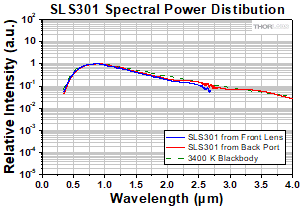
Click to Enlarge
Click for Raw Data
The measured spectral power distribution for the SLS301 Light Source.

Click to Enlarge
The control unit for the SLS301 source.
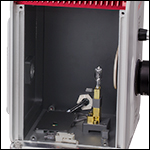
Click to Enlarge
The back port provides access to uncollimated light at longer wavelengths.
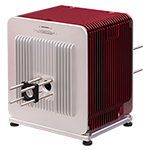
Click to Enlarge
The back of the SLS301 source with the removable plate taken out to incorporate 30 mm cage rods and fixed optic holder.
- 360 - 3800 nm Stabilized Light Source
- 360 - 2700 nm through the Front Lens
- 360 - 3800 nm through the Back Port
- >1.6 W Output Power Collimated in a Ø35 mm Beam
- Closed-Loop Control for High Stability
- Power Fluctuations of 0.05% within 1 Hour
- Color Temperature Stability: ±15 K
- Low Optical Drift: 0.01% per Hour / 0.1% per °C
- 30 mm and 60 mm Cage System Compatible
- Manual Shutter
Thorlabs' SLS301 Stabilized Quartz Tungsten-Halogen Light Source provides a constant intensity, >1.6 W blackbody radiation spectrum between 360 and 3800 nm. An internal feedback system is employed to achieve a highly stable power output (0.05% fluctuation). The >1.6 W output is collimated into a Ø35 mm beam for free-space applications. Since the blackbody spectrum spans both the visible and near-infrared spectral ranges, this source is ideal for integration into optical measurement equipment, such as back illumination for a test target as part of a detector calibration system. It can also be used as an illumination source in a white light interferometer for applications such as mapping surface structure.
The SLS301 is shipped with a factory-installed collimation lens. This configuration provides >1.6 W of free-space, collimated output power in a Ø35 mm beam. The lens tube of the collimation lens features internal SM2 (2.035"-40) threading for easy integration of SM2-threaded parts, including the liquid light guide adapters sold below. A knob on the front of the housing allows a manual shutter to block the output if desired.
The front face of the housing can integrate a 60 mm cage system, while the back face has a removable plate with four 4-40 taps to incorporate a 30 mm cage system centered around an SM1-threaded (1.035"-40) aperture. It should be noted, however, that the output from the back face is not collimated. This additional output is ideal for creating a reference signal, or to monitor the output of the SLS301 source without interfering with the Ø35 mm collimated beam.
The included controller, pictured above, has three LED indicator lights for temperature, lamp status, and lifespan. During normal operation, all three will be green. If the controller becomes overheated, the "Temperature" indicator will switch to red and the source will be automatically shut off. The "Lamp Status" indicator will show green if the correct lamp is installed in the SLS301 source, or red if no lamp is present or if the wrong lamp is installed. The "Lifespan" indicator shows yellow once the lamp reaches 75% of its lifespan and red once it reaches 100%.
The large housing design of the SLS301 source allows for the safe dissipation of thermal energy produced by the 150 W lamp. When used for an extensive amount of time, the housing can heat up to ~60 °C, so extensive contact should be avoided. Replacement lamps are sold below.
If a higher color temperature is desired, our color-balancing filters can be used to attenuate red light from the SLS301 light source while passing blue light. This results in a beam with a higher color temperature and lower total power.

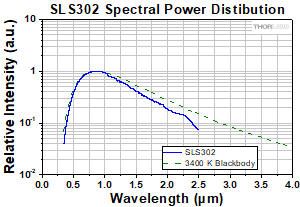
Click to Enlarge
Click for Raw Data
The measured spectral power distribution for the SLS302 Light Source.

Click to Enlarge
The control unit for the SLS302 source.
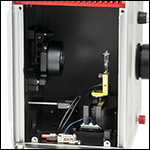
Click to Enlarge
A rear concave mirror on a kinematic mount maximizes output power.
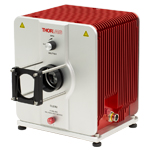
Click to Enlarge
The front of the SLS302 source supports integration with 60 mm cage systems.
- 360 - 2500 nm Stabilized Light Source
- >10 W Output Power Collimated in a Ø46 mm Beam
- Closed-Loop Control for High Stability
- Power Fluctuations of 0.05% within 1 Hour
- Color Temperature Stability: ±15 K
- Low Optical Drift: 0.01% per Hour / 0.1% per °C
- User-Adjustable Lamp Position
- ±3 mm in X and Z Axes
- ±2.5 mm in Y Axis
- 60 mm Cage System Compatible
- Manual Shutter
Thorlabs' SLS302 Stabilized Quartz Tungsten-Halogen Light Source provides a constant intensity, >10 W blackbody radiation spectrum between 360 and 2500 nm. An internal feedback system is employed to achieve highly stable output power (0.05% fluctuation). The high-power output is collimated into a Ø46 mm beam for free-space applications. Since the blackbody spectrum spans both the visible and near-infrared spectral ranges, this source is ideal for integration into optical measurement equipment, such as back illumination for a test target as part of a detector calibration system. It can also be used as an illumination source in a white light interferometer for applications such as mapping surface structure.
The SLS302 source is shipped with a factory-installed collimation lens. The lens tube of the collimation lens features internal SM2 (2.035"-40) threading for easy integration of SM2-threaded parts. Please note that the SLS302 source should not be used with our liquid light guides without active cooling of the LLG to prevent overheating and burning of the LLG tips. The front face of this source can also integrate a 60 mm cage system, as shown in the image to the right. A knob on the front of the housing allows a manual shutter to block the output if desired.
A concave mirror is mounted at the rear of the unit on a kinematic mount. Although the mirror is factory-aligned to maximize power output, three knobs on the rear panel allow the user to adjust the pitch, yaw and Z mirror position as needed. In addition, the housing also has a knob towards the bottom of each of three sides for adjusting the lamp position, which can be translated ±3 mm in the X and Z axes, as well as ±2.5 mm in the Y axis. As a result of these added mounting features, the ~142 mm beam height of the SLS302 source is approximately 30 mm higher than the other light sources features on this page.
The included controller, pictured above, has three LED indicator lights for temperature, lamp status, and lifespan. During normal operation, all three will be green. If the controller becomes overheated, the "Temperature" indicator will switch to red and the source will be automatically shut off. The "Lamp Status" indicator will show green if the correct lamp is installed in the SLS302 source, or red if no lamp is present or if the wrong lamp is installed. The "Lifespan" indicator shows yellow once the lamp reaches 75% of its lifespan and red once it reaches 100%.
The large housing design of the SLS302 source allows for the safe dissipation of thermal energy produced by the 150 W lamp. When used for an extensive amount of time, the housing can heat up to ~60 °C, so extensive contact should be avoided. Replacement lamps are sold below.
If a higher color temperature is desired, our color-balancing filters can be used to attenuate red light from the SLS302 light source while passing blue light. This results in a beam with a higher color temperature and lower total power.

- Couples the Output of the Broadband Light Source into a Liquid Light Guide (LLG)
- Active Cooling of LLG is Necessary if Used with SLS302 High-Power Light Source
- Adapters Designed for 185 nm - 2.1 µm or 350 - 700 nm Wavelength Range
- Compatible with Ø3 mm and Ø5 mm Core Liquid Light Guides
- SLSLLG2 Includes Integrated Electronic Shutter with External Controller
These Liquid Light Guide Adapters are designed to quickly and easily integrate with the SLS301 light source to couple the output into Ø3 mm or Ø5 mm core Liquid Light Guides (LLGs). The SLS302 high-power light source should not be used with liquid light guides without active cooling of the LLG to prevent overheating of the LLG tips. The adapters contain a collimating lens and are externally SM2 threaded (2.035"-40), allowing them to directly thread onto the collimation lens assembly without the need to remove or adjust either lens.
The SLSLLG1 is designed with an uncoated collimating lens, which provides a wide operating range from 185 nm - 2.1 µm. For superior performance from 350 nm - 700 nm, the SLSLLG2 and SLSLLG3 lenses use an AR-coated lens that provides improved coupling efficiency in this wavelength range. Transmission of wavelengths longer than 800 nm through the LLG for longer than an hour may result in permanent damage to the LLG tip; to reduce damage during extended use, incorporate a filter to limit transmission of IR wavelengths.
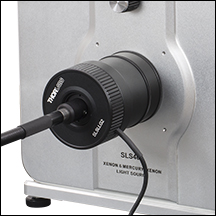
Click to Enlarge
The SLSLLG2, with a liquid light guide, attached to the SLS402 Light Source.
The SLSLLG2 features an integrated diaphragm shutter and an external controller that can operate at continuous frequencies up to 10 Hz and burst frequencies up to 15 Hz. For more information on the integrated shutter, please refer to the manual.
All liquid light guide adapters come with the AD3LLG adapter preinstalled, making them compatible with Ø3 mm LLGs out of the box. They are also shipped with the Ø5 mm LLG-compatible AD5LLG adapter, which can be swapped in by unthreading the AD3LLG and replacing it with the AD5LLG.
| Item # | SLSLLG1 | SLSLLG2 | SLSLLG3 |
|---|---|---|---|
| Wavelength Range | Uncoated: 185 nm - 2.1 µm | AR Coated: 350 nm - 700 nm; Ravg < 0.5% | |
| Integrated Electronic Shutter | No | Yesa | No |
| Lens | LA4464 | ACL5040U-A | |
| Lens Material | UV Fused Silica | B270 Optical Crown Glass | |
| Coupling Efficiency (with SLS301)b | >15% (3 mm LLG); >25% (5 mm LLG) | >20% (3 mm LLG); >30% (5 mm LLG) | |

- Replacement Quartz Tungsten-Halogen Lamp for SLS301 or SLS302 Stabilized Light Sources
- Electrical Power: 150 W
- Color Temperature: 3400 K (Refer to the Graphs Tab for Typical Spectra)
- Ozone Free Lamp
This SLS301B replacement lamp is compatible with the SLS301 and SLS302 light sources. Please see the Lamp Replacement tab for detailed instructions.
Note: We strongly recommend wearing gloves when replacing the lamps in our light sources to prevent skin oils from being deposited onto them. If you suspect the lamp is dirty, carefully clean it with alcohol before connecting it to a power supply.
 Products Home
Products Home















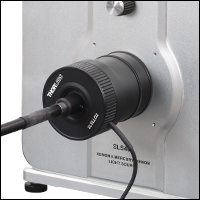

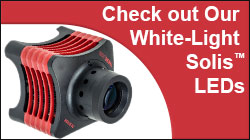

 Zoom
Zoom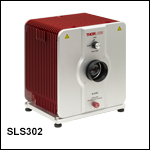
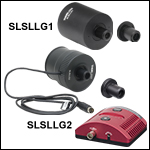
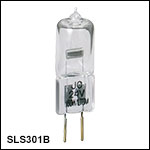
 Stabilized Tungsten-Halogen Light Sources
Stabilized Tungsten-Halogen Light Sources